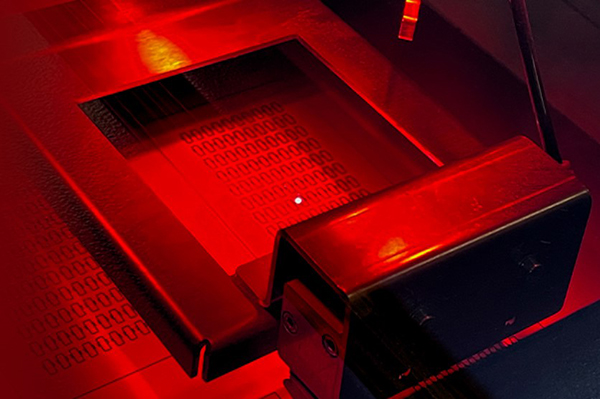Laser Micro-machining

We have two laser machining systems, UV and IR
LPKF Microline 5120 Laser Milling Machine (UV)
The LPKF Microline 5120 laser milling machine (10 watts ultra violet, UV) is a universal tool. It drills and cuts panels up to 533 mm × 610 mm. Width of cut is only 20µm, and it cuts demanding contours at high speeds. An integrated vision system ensures fast fiducial recognition and precise alignment. The camera uses almost any PCB feature as a fiducial mark. An integrated power measurement device determines the laser power at the cutting face giving reliable and repeatable control. The sweet spot for the machine is drilling small holes (c. 100um) in organic materials (FR4 resin) and thin copper ( 35um. UV lasers ablate organic materials. UV energy tears organic molecules apart. This ablative effect has no impact on metals, and the cutting action required is reliant on heat from the laser which is only sufficient to cut thin metal layers. UV laser systems with this wavelength of 355 nm are especially suitable for micro-processing of metals, plastics, ceramic materials and material composites.
LPKF G6060 Laser Solder Paste Stencil Cutting Machine (IR)
The LPKF G6060 laser solder paste stencil cutting machine (infrared, IR) is mostly used for cutting stainless steel stencils on material up to 0.5mm thick, but typically in the 0.1mm range. It is equally effective for general purpose machining of small parts in all manner of sheet metals with high accuracy. Holes as small as 25um can be drilled, and sheets as large as 600mm x 450mm can be contoured with unlimited complexity. The infra laser heats the metal to the point where a fine jet of air compressed makes a clean cut by oxidising the metal in its path. This laser is most effective cutting metal. IR laser systems with this wavelength of 1064 -1090 nm are also suitable for direct copper structuring of HF and microwave circuits.
Data
Data should be presented in Gerber combined with notes as to what the features represent. Lasers will remove material, so the documents must be clear as to which features represent the path of the laser. For example, pads might indicate a contour cut to create a pad size aperture, or they might indicate a pad sized shape to be ablated down to a copper base.
Process Development
Newbury Electronics has many years of experience in laser micro-processing. We are happy to provide proof of concept test samples. Our range of services includes assistance with selection of suitable materials and prototype production. Our application engineers will assist with optimising the production process.